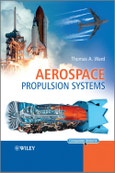- Covers all engine types, including piston aero engines
- Design principles presented in historical order for progressive understanding
- Focuses on major elements to avoid overwhelming or confusing readers
- Presents example systems from the US, the UK, Germany, Russia, Europe, China, Japan, and India
- Richly illustrated with detailed photographs
- Cartoon panels present the subject in an interesting, easy-to-understand way
- Contains carefully constructed problems (with a solution manual available to the educator)
- Lecture slides and additional problem sets for instructor use
Advanced undergraduate students, graduate students and engineering professionals new to the area of propulsion will find Aerospace Propulsion Systems a highly accessible guide to grasping the key essentials. Field experts will also find that the book is a very useful resource for explaining propulsion issues or technology to engineers, technicians, businessmen, or policy makers. Post-graduates involved in multi-disciplinary research or anybody interested in learning more about spacecraft, aircraft, or engineering would find this book to be a helpful reference.
Table of Contents
Preface ix
Acknowledgments xi
Outline of Aerospace Propulsion History xiii
Nomenclature xvii
1 Fundamentals 1
1.1 Fundamental Equations 2
1.1.1 Review of Terms 4
1.1.2 Equation of State for a Perfect Gas 12
1.1.3 Law of the Conservation of Mass 13
1.1.4 Law of the Conservation of Linear Momentum 15
1.1.5 Law of the Conservation of Energy 17
1.2 Isentropic Equations 21
1.2.1 Isentropic Relationship between Temperature and Pressure 21
1.2.2 Isentropic Relationships with Specific Volume 23
1.3 Polytropic Processes 25
1.4 Total (or Stagnation) Properties 25
1.5 Isentropic Principles in Engine Components 31
1.5.1 Ducts 31
1.5.2 Turbomachinery 34
1.5.3 Combustion Chambers (Combustors) 34
1.5.4 Nozzles 34
1.6 Shock Waves 41
1.6.1 Normal Shocks 42
1.6.2 Oblique Shocks 46
1.6.3 Conical Shocks 50
1.7 Summary 51
References 51
Problems 51
2 Rockets 57
2.1 Background Description 57
2.2 Performance of an Ideal Rocket 60
2.2.1 Rocket Thrust Equation 63
2.2.2 Total and Specific Impulse 66
2.2.3 Effective Exhaust Velocity 68
2.2.4 Rocket Efficiencies 69
2.2.5 Characteristic Velocity 70
2.2.6 Thrust Coefficient 74
2.3 Solid Rocket Motors 81
2.3.1 Colloidal (Homogenous) Propellants 83
2.3.2 Composite (Heterogeneous) Propellants 90
2.3.3 Composite Modified Double-Based Propellants 93
2.3.4 Solid Propellant Grain Geometry 93
2.3.5 Solid Rocket Motor Casing 102
2.3.6 Combustion of Solid Propellants 103
2.3.7 Solid Rocket Ignition Systems 107
2.4 Liquid Rockets 111
2.4.1 Liquid Rocket Propellants 111
2.4.2 Liquid Rocket Feed Systems 124
2.4.3 Liquid Rocket Injection Systems 125
2.4.4 Combustion of Liquid Propellants 127
2.4.5 Liquid Rocket Ignition Systems 129
2.5 Hybrid Rockets 130
2.6 Motor Casing 131
2.7 Thrust Chamber 133
2.8 Exhaust Nozzles 137
2.9 Multi-staging 141
2.10 Non-chemical Rockets 149
2.11 Rocket Design Methodology 150
2.12 Summary 160
References 161
Problems 162
3 Piston Aerodynamic Engines 171
3.1 Background Description 171
3.2 Engine Types 176
3.2.1 Rotary Engines 176
3.2.2 Reciprocating Engines 178
3.2.3 Supercharged Reciprocating Engines 191
3.2.4 Gas Turbine Propeller Engines 194
3.3 Thrust 198
3.4 Combustion 202
3.4.1 Aviation Fuel 202
3.4.2 Specific Fuel Consumption 205
3.5 Propeller Design 213
3.5.1 General Description 213
3.5.2 Power Efficiencies 217
3.5.3 Variable Pitch Blades 225
3.5.4 Propeller Shapes 227
3.5.5 Contra-Rotating Propellers 228
3.5.6 Helicopter Rotor Blades 229
3.6 Propeller Performance 230
3.7 Summary 239
References 239
Problems 240
4 Gas Turbine Engines 247
4.1 Background Description 247
4.2 Ideal Gas Turbine Cycle 253
4.3 Types of Gas Turbine Engines 255
4.3.1 Jet Propulsion Engines 255
4.3.2 Shaft Power Engines 260
4.4 Engine Cycle Performance 264
4.4.1 Jet Propulsion Thrust 264
4.4.2 Shaft Power Thrust 267
4.4.3 Propulsive Efficiency 268
4.4.4 Thermal Efficiency 270
4.4.5 Overall Efficiency 270
4.4.6 Specific Fuel Consumption 271
4.5 Component Performance 272
4.5.1 Intakes 272
4.5.2 Compressors 275
4.5.3 Turbines 276
4.5.4 Combustion Chambers (Combustors) 277
4.5.5 Exhaust Nozzles 279
4.6 Engine Performance Analysis 281
4.7 Design Point Optimization 321
4.8 Component Design 326
4.8.1 Intake Design 326
4.8.2 Compressor System Design 338
4.8.3 Combustion Chambers 357
4.8.4 Turbines 366
4.8.5 Exhaust Systems 372
4.9 Engine Control Systems 378
4.10 Summary 379
References 379
Problems 380
5 Ramjet and Scramjet Engines 395
5.1 Background Description 395
5.2 Ramjet Engines 400
5.2.1 Conventional Ramjet Engines 400
5.2.2 Turboramjet Engines 403
5.2.3 Analysis of Ramjet Engines 404
5.2.4 Ramjet Component Design 426
5.3 Scramjet Engines 431
5.3.1 Description 431
5.3.2 Scramjet Component Design 434
5.4 Summary 437
References 438
Problems 438
Appendix A: Gas Tables 445
Appendix B: Isentropic Flow Tables 449
Appendix C: Shock Tables 475
Appendix D: Rocket Propellant Tables 505
Solutions to Even Numbered Problems 511
Index 515








